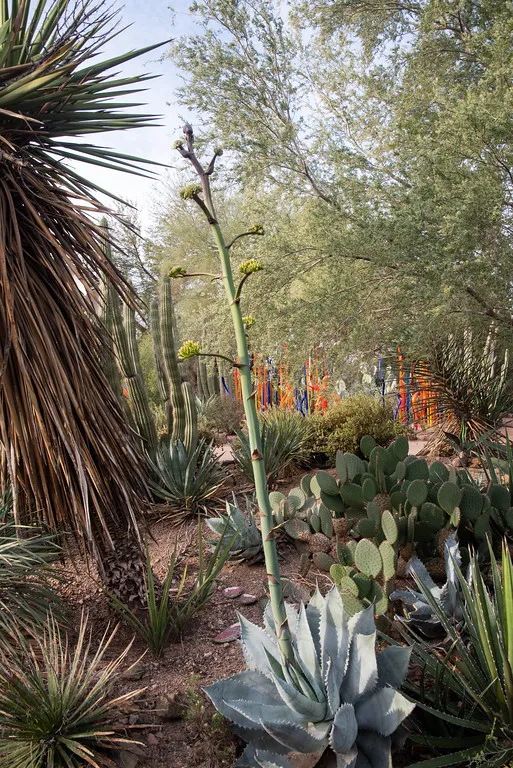Hello! The first plant profile is going to be Agave! My current plant crush. This is a fascinating and beautiful plant that has captivated my attention for many years now.

Variegated Agave "Engard", Central Arizona
The plant profile will cover
Genus
Common Name
Description
Habitat
Ideal growing conditions
Life cycle
Type
Flowers/fruit
Propagating
Uses
Interesting facts

Hedgehog Agave, Central Mexico
Genus: Agave
Common Name: Agave, Century Plant
Spanish names: mezcal, mescal, maguey, amole
Most agave originate and are still found in Mexico.
Description:
Agaves are characterized by a rosette of succulent (water retaining) or leathery leaves that range in size from a few centimetres to more than 2.5 metres (8 feet) in length, depending on the species. Most bear spines along the edges and the tip of the leaf, for which they are occasionally confused with unrelated cacti.

The leaves range in colour from pale green to blue-grey and can be variegated or striped.
 |  |  |
|---|---|---|
 |  |  |
Sometimes the leaves are so tightly compressed that they imprint on each other.




Habitat is the natural home or environment of an animal, plant, or other organism.
Agave is native to arid (dry) and semiarid (part dry) regions of the Americas. From Utah, California, and Arizona in the southwestern part of North America through Mexico (where the most species are found), with a few in northern South America and on Caribbean Islands.

 |  |  |
|---|---|---|
| 'Shark Skin' Agave, N. Mexico | Black Spined Agave, Oaxaca and Puebla, Mexico | Shin Dagger Agave, S. Arizona to NW Mexico |

Ideal Growing conditions
| Sun exposure | Full | |
|---|---|---|
| Soil | Sandy, well drained | |
| Water | Moderate to light | |
| USDA Hardiness Zone | mainly 8 or 9 |
The biggest problem with growing agave is overwatering them.

Parry's agave
The majority of agave plants can't tolerate frost and only can grow as far north as USDA growing zones 8 or 9. But there are some, such as Agave parryi, that are reliably perennial to zone 5. Moreover, most agaves prefer a climate with low humidity.

Life Cycle
The life cycle in plants is a series of stages, from the germination of the seed to the completion of reproduction of that plant.
The life cycle (especially the blooming) is one of my favorite and saddest parts of an agave.
- Seed or pup (little new plants)
- Young plant
- Mature plant, 10+ years
- Blooming. Agave send a stalk up. They grow very tall, most 6-10 feet (1.82-3.04 meters) and some as much as 30 feet (9.1m)!
Most agaves live 15-30 years and send up the stalk at the end of their life. - The stalk flowers
- The agave dies
Type
Agave are Monocarpic plants produce seeds only once, but may take several years to grow to maturity.
The Agave life cycle in pictures.
 |  |  |
|---|---|---|
 |  |  |
 |  |  |
|---|---|---|
 |  |  |
Flowers/Fruit
There are several types of stalks and flowers on the agave plants. For most agave the bloom lasts 3-4 months. The flowers produce a sweet nectar that is made into sugar. I actually use agave syrup for my sweetener most of the time.
 |  |
|---|

Propagating
Agave propagates in a couple of ways.
- It has thousands of seeds on the stalk it sends up at the end of it's life.
- It also sends out "pups" from the mother plant.
I got this plant as a young agave from a gardener at ASU, about two years ago. It has since produced many pups. I called it mother. Now the baby plants are having their own pups so she is grandma now!

Uses

The main uses of agave are food, fiber and ornamentation .
When the agave sends up the stalk it produces edible flowers, nectar or sugar. In some varieties you can make alcohol like Tequila and Pulque.
The people of Mexico and the native American's in the southwest used the fibers for ropes, brushes, sandals, nets and sleeping mats. They also used the leaves to line baking pits and thatch huts. And the sharp tips for needles.
What a wonderful desert plant useful, tasty and so beautiful.
Agaves are uses in a lot of desert landscaping. I have multiple agave in in my plant collection on the back porch. I love the look of agave!




Here you can see how Chihuly highlighted the agave with his Neodymium Reeds at the Desert Botanical Garden during the Chihuly in the Desert exhibition.


Interesting facts
According to International Organic Agave Alliance:
Human remains dating back at least 10,000 years show the early uses of agave for food and fiber. The agave plant has long been part of human culture and was already ancient when the Spaniard Conquistadors arrived in the Americas in 1492.
In the 1990’s a method was used to produce alternative and organic sweetener agave syrup. Today, close to 10 % of total agave production is used for agave syrup, with most coming from Blue Agave.
There are 136 known species of agave and the Blue Agave is the only one used to produce tequila.
I don't know much about tequila I do have a beautiful Blue glow Agave.

My favorite is Queen Victoria Agave. It has a stunning rosette and simple, classic lines.

 |  |  |
|---|
I have the large grandma plant (Agave Americana) and a couple of her offspring. I also have a blue agave and a Queen Victoria.
Sources:
Life cycle of a Plant
USDA Hardiness Zone
Desert Museum- Genus Agave
Britanica.com-Agave
Wikipedia-Agave
New World Encyclopedia-Agave
The Spruce- Agave
Plant Care Today- Agave
Note: Most pictures were taken at the Desert Botanical Garden during the past 6 months. .
